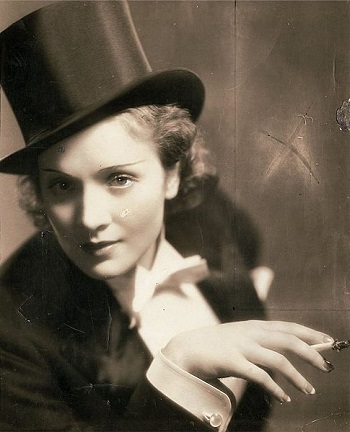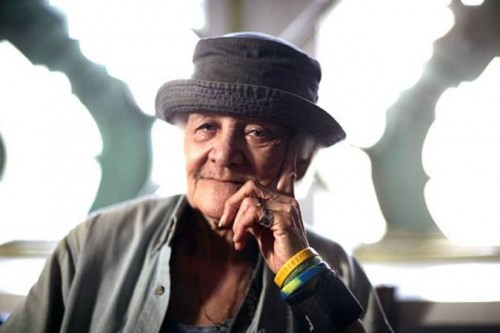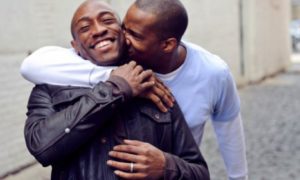Opinion: Why Do We Feel the Need to Transgender the Dead?
Earlier this month, a list of vaudeville-era “non-binary and transgender public heroes” compiled by actor Jeffrey Marsh was circulated widely on social media. The accompanying photos are fascinating, which helps explain why the list has been re-Tweeted more than 7,000 times. But notwithstanding the above-quoted title, only one of the listed entertainers are actually transgender. Nor did any of them call themselves “non-binary”—since the term didn’t exist until recently. Rather, what Marsh actually has provided is a list of people who cross-dressed—a practice that was common in the days of vaudeville and early cinema, largely because audiences found it entertaining.
Below is a thread of B&W pics of openly nonbinary/trans/gender-fun public heroes all from about 100 years ago??
People all over the world were out, open and celebrating themselves 1/ https://t.co/bgFwIuNaog
— jeffrey marsh (@thejeffreymarsh) August 4, 2018
One of the listed figures is Marlene Dietrich, who dressed in male clothing and kissed another woman in the 1930 film, Morocco. But Dietrich was not trans, even if, like many of her stage contemporaries—including Bessie Bonehill, Vesta Tilley, Ella Wesner and Gladys Bentley—she experimented with gender-bending. (The word Dietrich would have used to describe this practice, I suspect, would have been acting). Marsh’s statement that Dietrich “openly dated folks of various genders” is inaccurate in that Dietrich dates both sexes given that Dietrich was bisexual—but that has nothing to do with what costumes she wore as an actor.
Marsh’s list symbolizes a larger trend whereby dead gay men and women—as well as bisexuals, and others who cross-dressed for reasons completely unrelated to their actual identity—are claimed by today’s social activists as transgender. Leaders in this movement have included Harry Benjamin, a German-born American doctor whose 1966 book, The Transsexual Phenomenon, blurred the line between performative cross-dressing and actual (as we would now call it) transgenderism. Anticipating the modern age of trans activism and himself the medical force behind pushing for transsexualism within the field, Benjamin announced the “transsexualism” of various gay historical figures: King Henry III of France, the Abbé de Choisy (whose memoirs reveals that he cross-dressed); and, apparently, the entirety of the Yuman people living in what is now California and Mexico (based on Benjamin’s misunderstanding of the concept of two-spiritedness within some indigenous cultures).
In our own era, no historical figure is too sacred to escape retroactive trans recruitment—not even Stormé DeLarverie, the black butch lesbian credited with starting the Stonewall riots in 1969. As Claire Heuchan notes, many of the same activists who once acted as feminist and gay-rights champions now have decided that the best way to “celebrate a woman’s achievements” is to “credit a man.”
Last month, controversy erupted after it was announced that Scarlett Johansson was to play the role of Dante “Tex” Gill (born Jean Marie Gill) in a film titled Rub & Tug. Gill (1930-2003) was a Pittsburgh-based pimp, mobster, drug dealer, and massage parlor owner who chose to live under a male identity. After the film was announced for production, articles appeared with titles such as “13 Trans Actors to Follow Instead of Scarlett Johansson” and “Trans Actors Protesting Scarlett Johansson’s Trans Role Are Told They’re Jealous, Unskilled Whiners.” Stung by the accusation that she was stealing a job that should properly go to a trans actor, Johansson quit the project (which is now, predictably, in limbo, following the departure of its star). And pundits debated whether it is legitimate to demand that trans characters be played by trans actors. But such discussion assumes the fact of Gill’s transgender identity. Throughout history, many women—lesbians especially—engaged in cross-dressing for no other reason than to escape homophobia, and to get by in intensely sexist milieus (such as, for instance, the criminal underworld).
This field of social history has been thoroughly researched and documented by academics for decades. In her 1992 book, Vested Interests: Cross-Dressing and Cultural Anxiety, for instance, Harvard professor Marjorie Garber profiles dozens of famous (and infamous) cross-dressers throughout history—right up to Madonna, David Bowie, Prince and Little Richard. In Garber’s view, cross-dressing has existed as both symptom and catalyst for cultural anxiety, whereby the transvestite (her term) challenges society’s prevailing definitions of masculinity and femininity.
Garber began Vested Interests with the claim that “there can be no culture without the transvestite”—a term that, distinct from “transgender,” signifies a person (usually a man) who enjoys presenting himself in clothes and fashions associated with the opposite sex, but who retains a gender identity (to use the modern formulation) assigned at birth. A quarter-century later, usage of the word transvestite has become heavily stigmatized, as it suggests cross-dressing to be a mere act. Thus has the inspirational gay-rights and AIDS activist Marsha P. Johnson been reinvented posthumously as transgender, even though he identified himself explicitly as a gay man and a drag queen right up until his tragic death in 1992. Too often, trans activists prefer to ignore the quotidian realities that (a) many men have enjoyed or profited from dressing up as women since time immemorial; and (b) many women (lesbians, especially) have cross-dressed throughout history as a strategy to avoid or deflect the stifling social norms associated with femininity.
Garber examines the life of Billy Tipton, born Dorothy Lucile Tipton, a jazz pianist who formed the Billy Tipton Trio and started touring the Pacific Northwest during the Great Depression. Tipton had five common-law wives, adopted three children, and was understood by friends and family to be a heterosexual man. That is, until paramedics were called to revive Tipton in 1989 due to a hemorrhaging peptic ulcer—upon which time Tipton was discovered to be biologically female.
Much energy has been invested in re-writing Tipton’s history as a trans narrative. Yet the evidence suggests that Tipton was a lesbian who also happened to be pursuing a career as a jazz musician—an ambition that would have been difficult or impossible for a woman to realize in the early 20th century. Despite evidence that Tipton was involved in several lesbian relationships, the musician has become one of many who’ve been posthumously transitioned by others—a process of “dead trans-ing” that, as writer Carrie-Anne Brownian noted, typically involves rewriting a historical figure’s life in a way that erases their homosexuality.
Historical figures such as Hatshepsut, Joan of Arc, Queen Christina, Ann Bonny, Mary Read, Ulrika Eleonora Stålhammar, Hannah Snell, Charley Parkhurst, Carson McCullers, Radclyffe Hall and Norah Vincent represent just a handful of the applicable case studies: women who found it easier to lead armies and nations, command pirate ships, drive stage coaches, or write books when they presented themselves as men. George Sand and Colette both wore men’s clothes, as did James Barry, the female doctor credited with performing the first successful Caesarean section in the UK. (Like Tipton, Barry was assumed to be a man until her death, at which time it was discovered she was female.) Moreover, should we be surprised that, at a time when women generally were barred from military service, someone such as Frances Clayton would fight in the U.S. Civil War among roughly 400 other cross-dressing female members of the Union army? Even Kathrine Switzer, the first woman to run the Boston Marathon, once had to pretend to be a man in order to register with race officials—just as women in today’s Saudi Arabia regularly cross-dress in order to drive cars or infiltrate social spaces from which they are formally excluded.
Rather than acknowledge how sexism has caused such women to distort their identity in order to achieve their ambitions, the modern trend is to play down the underlying sexist and homophobic bigotry of the past. On Slate, for instance, Alex Myers argued recently that the:
“[I]nsistence on a progress narrative distorts our understanding of gender and history. By repeatedly asserting that women only dressed as men to gain some advantage, we dismiss the notion that some women understood themselves to be men—regardless of whether that gained them anything or not. Of course, for those living in a misogynistic culture, passing as a man absolutely grants privilege. That’s an inescapable fact. But that doesn’t mean that access to this privilege was always the motivating factor for a woman to live as a man.”
Myers’ use of the term “privilege” is strange. The historical campaign for women’s rights was motivated by a desire for a life free from rape (both within and without marriage), domestic abuse, oppressive honor codes and sexist professional strictures. If not being forced to bear a dozen children while enduring a forced marriage qualifies as “privilege,” then the word loses all meaning. By means of such linguistic slippages, activists construct fictional worlds in which women want to be men, as opposed to simply seeking liberation from bigotry.
“It’s homophobia, it keeps happening, and I’m so tired of my own community rewriting history,” is how Lesbian filmmaker Amy Dyess describes the transitioning of dead lesbians. “In the past, pronouns (he, him, she, her) were used interchangeably and affectionately in the gay community. Gay men have addressed each other as ‘girl,’ lesbians have addressed each other as ‘bro,’ ‘dude,’ ‘papi,’ and so on. It didn’t mean the same thing, and sometimes it was a matter of survival. In the [American] south, I asked a girlfriend to stop correcting everyone who mis-gendered me…because it was safer for both of us that way.”
Butch women and effeminate men always have employed wardrobe innovations to signal their homosexuality to other members of the gay community—just as cross-dressing became a way for gay men and women to escape persecution by hiding in plain sight. Anyone who wonders why Joan of Arc continued to wear men’s clothes in prison need only crack a book on the history of this era: She didn’t want to be raped. Much in the same way that Mexican baroque-era nun, scholar, poet and playwright Sor Juana Inés de la Cruz considered cross-dressing as a means to gain access to university education. It wasn’t that these women cross-dressed to be men. It’s that they cross-dressed not to be women. In the specific case of gay women, this coping mechanism, if employed successfully, also came with the ability to refuse marriage, to develop one’s professional ambitions and to build wealth.
The tension I am describing here is sometimes dismissed as a mere subcultural feud between radical feminists and trans advocates. But the trans-ing of the dead now has gone mainstream. Even The New York Times has falsely tried to recast Marsha P. Johnson as a “transgender pioneer.” And Anne Lister, whose 18th centuries diaries described the details of her lesbian relationships in her native Yorkshire, was transed during a recent LGBT History Month event, when the York Civic Trust unveiled a historic plaque on the church where Lister and her partner, Ann Walker, took their commitment vows. Eschewing any reference to Lister’s life as a lesbian, the plaque’s creators labeled her “gender-nonconforming.”
Activists in the trans community have long claimed that gender isn’t about vestiture, but about an inner sense of self. But this theory doesn’t pan out in the real world, which is what history should record. The trans-ing of the dead therefore should be seen as part of this effort to rewrite history in a fictional way: Every instance of cross-dressing, whether on stage or off, is spuriously interpreted to mean that the figure in question was communicating some secret truth about their “gender-nonconforming” souls. For those of us who have long championed gay rights, it feels like a ghoulish, faux-enlightened form of gay-conversion therapy.
These cultural grave-diggers imagine themselves to be fashionably transgressive. But what they are really peddling is a deeply conservative notion of what it means to be male or female. According to this conception, the lesbianism of historical figures is reimagined as a rejection of womanhood itself, just as the act of dressing as a woman for stage or fetish is reimagined as a rejection of manhood. The dead cannot possibly speak for themselves. So, it is up to the rest of us to ensure that the true narratives of feminist pioneers, gay men and lesbians are not removed from the pages of history.
[Originally published on Quillette]
About author
You might also like
Troye Sivan’s ‘Bloom’ Elegantly Combats Bottom Shame
In the wonderful world of gay sex, “bloom” can mean many things: a hole stretching open around a cock, a gape after that first slick pull-out, or a rosebud (or
LOVING THE PAST AND THE PRESENT (A ‘One True Loves’ Review)
This book first came to my attention when I saw the trailer for its movie adaptation on YouTube. And like I do whenever I see the trailer of any film
Opinion: After Jussie Smollett, Will Real Victims of Anti-LGBT Hate Crimes Be Heard?
Jussie Smollett just made it that much harder for the United States to have an honest conversation about anti-LGBT violence. What’s especially painful is how urgent that conversation remains. On
















4 Comments
Mitch
March 19, 08:41The last paragraph says everything that needs to be said on the issue of lumping cross-dressing together with being transgender.
That one crossdresses doesn’t make one transgender.
If that was the case, RuPaul and the bajilion other drag queens out there would have transitioned to women by now.
Through RuPaul’s Drag Race history, less than 5 contestants on that show have transitioned into women. If we have to go by what Jeffery Marsh is saying, then, heck, they’d all be women.
And Scarlet Johansson would be a man.
Las Las, wokeness isn’t sense.
Not all issues should be lumped together.
Avid fan
March 19, 12:53This post should be spread everywhere!!! The writer is lit!
Keredim
March 19, 14:33These cultural grave-diggers imagine themselves to be “fashionably transgressive”
Feels like “Trans-terrorism“
trystham
March 19, 17:44Its not only the trans-aggression that bothers me. It is the entire thing that does. Doesn’t all this speculating give u ppl headache? In our bid to validate our queer history, we come off as VERY desperate. I believe quite a number of our ‘queer heroes’ lived so much of controversial lives enough that it really wouldn’t have mattered much if they claimed they were queer. As such if they didn’t, it most likely means they weren’t. Does it change the reality that queer ppl have existed before now? No. Even if they weren’t existing, we are here now, Evolution backs our current existence. Let dissenters gaan die abeg